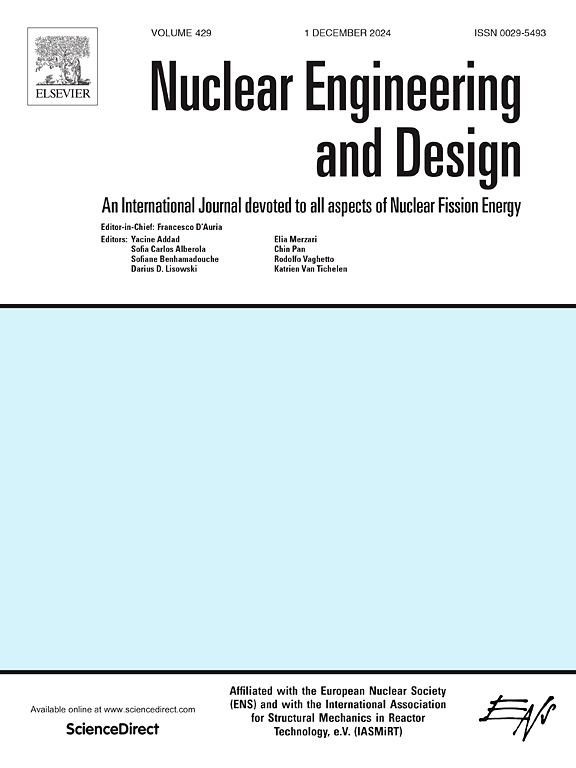Fire modelling of a glove box for use in a two-zone fire model
IF 1.9
3区 工程技术
Q1 NUCLEAR SCIENCE & TECHNOLOGY
引用次数: 0
Abstract
Accidental fires in nuclear fuel manufacturing and reprocessing plants can cause the glove box containment to rupture with a risk of dispersion of radioactive materials within the installation. Fire safety analyses require an assessment of the resulting radiological consequences to reinforce the appropriate prevention and protection measures in these installations. Since 2019, a research project named FIGARO aims at reducing the uncertainties related to the assessment of the airborne release fraction of plutonium involved in glove box fires. As part of this project, a semi-mechanistic model of glove box fire was developed and implemented in the two-zone code SYLVIA. Modelling glove box fires is a challenging task due to complex phenomena occurring in the glove box during its combustion. No theory has yet been put forward on how to model all aspects of the problem, even for simple, open atmosphere conditions. This model separates the combustion of the polycarbonate containment walls of the glove box from that of the biological protection panels, by modelling a glove box as a set of horizontal and vertical walls. A validation of this model was performed on two large-scale glove box fire tests carried out in a confined and mechanically ventilated enclosure (BAG_CSS experiments). Note that some parameters of the glove box model have been calibrated on the glove box qualification test carried out in an open atmosphere, under a calorimetric hood. Considering this preliminary calibration, the fire heat release rate is well reproduced by the model for both experiments.
用于两区火灾模型的手套箱的火灾模型
核燃料制造和后处理工厂的意外火灾可能导致手套箱安全壳破裂,造成放射性物质在装置内扩散的危险。消防安全分析需要评估由此产生的辐射后果,以加强这些设施的适当预防和保护措施。自2019年以来,一项名为FIGARO的研究项目旨在减少与评估手套箱火灾中涉及的钚的空气释放分数相关的不确定性。作为该项目的一部分,开发了手套箱火灾的半机械模型,并在两个区域代码SYLVIA中实现。由于手套箱在燃烧过程中会发生复杂的现象,因此建模是一项具有挑战性的任务。目前还没有理论能说明如何对这个问题的所有方面进行建模,即使是简单的开放大气条件。该模型通过将手套箱建模为一组水平和垂直壁,将手套箱聚碳酸酯密封壁的燃烧与生物保护板的燃烧分离开来。在密闭和机械通风的封闭环境中进行的两次大型手套箱着火试验(BAG_CSS实验)验证了该模型。请注意,手套箱模型的一些参数已在开放气氛下,在量热罩下进行的手套箱鉴定测试上进行了校准。考虑到这一初步校准,该模型在两个实验中都能很好地再现火灾热释放率。
本文章由计算机程序翻译,如有差异,请以英文原文为准。
求助全文
约1分钟内获得全文
求助全文
来源期刊

Nuclear Engineering and Design
工程技术-核科学技术
CiteScore
3.40
自引率
11.80%
发文量
377
审稿时长
5 months
期刊介绍:
Nuclear Engineering and Design covers the wide range of disciplines involved in the engineering, design, safety and construction of nuclear fission reactors. The Editors welcome papers both on applied and innovative aspects and developments in nuclear science and technology.
Fundamentals of Reactor Design include:
• Thermal-Hydraulics and Core Physics
• Safety Analysis, Risk Assessment (PSA)
• Structural and Mechanical Engineering
• Materials Science
• Fuel Behavior and Design
• Structural Plant Design
• Engineering of Reactor Components
• Experiments
Aspects beyond fundamentals of Reactor Design covered:
• Accident Mitigation Measures
• Reactor Control Systems
• Licensing Issues
• Safeguard Engineering
• Economy of Plants
• Reprocessing / Waste Disposal
• Applications of Nuclear Energy
• Maintenance
• Decommissioning
Papers on new reactor ideas and developments (Generation IV reactors) such as inherently safe modular HTRs, High Performance LWRs/HWRs and LMFBs/GFR will be considered; Actinide Burners, Accelerator Driven Systems, Energy Amplifiers and other special designs of power and research reactors and their applications are also encouraged.
 求助内容:
求助内容: 应助结果提醒方式:
应助结果提醒方式:


